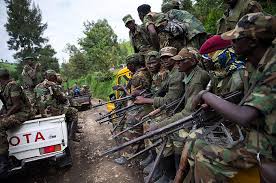M23 Armed Group

- 24 Jan 2025
In News:
The March 23 Movement (M23), a rebel group active in eastern Democratic Republic of Congo (DRC), has intensified its insurgency in North Kivu province, capturing key areas like Minova and threatening the provincial capital, Goma.
About M23 Armed Group:
- Full Form: March 23 Movement
- Formation: 2012, by mutineers from the Congolese army protesting a failed 2009 peace deal.
- Base of Operations: Eastern DRC, primarily in North Kivu province.
- Activities: Armed rebellion, territorial control, ethnic conflict, disruption of state authority.
External Support:
- Rwandan Involvement:
- UN Reports (2023): Estimated 3,000–4,000 Rwandan troops operating alongside M23.
- Rwanda alleged to have “de facto control” over M23 operations.
- Kigali denies direct territorial aggression claims.
- International Concerns: The group’s resurgence reflects broader regional instability and transnational military dynamics.
Recent Developments (2024):
- Territorial Gains: Capture of Minova; encroachment on Goma, a strategic and densely populated city.
- Humanitarian Crisis:
- Over 2,30,000 displaced since January 2024.
- Influx of injured civilians in hospitals; risk of further displacement and violence.
- Congolese Military Weakness:
- Internal instability and operational setbacks have contributed to M23’s advances.
- The Congolese army acknowledged a “breakthrough” by M23 with external backing.
Geographical Significance of the Region:
- DRC Capital: Kinshasa
- Strategic Location: Borders 9 countries—Angola, Zambia, Tanzania, Burundi, Rwanda, Uganda, South Sudan, Central African Republic, Republic of Congo.
- Topography:
- Rwenzori & Virunga Mountains: Includes active volcanoes (e.g., Mount Nyiragongo).
- Congo River: Vital for transport, hydroelectric power, and biodiversity.
- Natural Resources:
- Rich in cobalt, coltan, gold, and other rare minerals—critical to the global tech industry.
- The mineral wealth of North Kivu is a major driver of prolonged conflict.
